Toys
I have a an interest in pre-wwII toy cars and trucks
manufactured by Wyandotte. I collect nursery magic lanterns and lantern slides. These old
precursors to slide projectors combine my interest in optics and the
kerosene era.
Pattern Glass
We collect an early
American
Pattern Glass pattern, York Herringbone (sometimes called Scalloped
Swirl.) Here is a nice sample (72Kb) of a ruby stained
celery in this pattern.
More samples and information about this pattern can be found on the
Scalloped Swirl page.
We are looking for goblets, wines and tumblers in
either crystal or ruby stained.
If you have any interesting York Herringbone pieces please drop us a
note.
Spode
Sandy collects two Copeland Spode patterns:
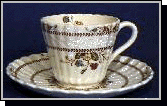
|
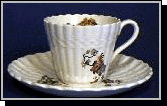
|
|
Copeland Spode, Cowslip
|
And Wicker Lane
|
And demi cups and saucers in any of the other Spode patterns.
Scientists and Technology
I am looking for any plates, pitchers or other glass, pottery, china, etc.
pieces with portraits or at least references to scientists, engineers, or
scientific or technology events. For example, Einstein, Bohr, Newton,
Darwin, Priestly, Edison, Tesla, etc. I have managed to find only two
plates of this sort: a Royal Copenhagen plate celebrating Oersted, a
Wedgewood plate celebrating the return of Halley's comet, and token with the
bust of Edison made for Shell oil, and a wonderful caricature of Wm. Crookes by
'Spy'. Let me know if you have any to sell.
Note that I am not interested in pieces commemorating exploration.
Can You Help Date This?
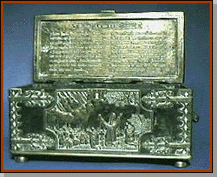 Small (7-5/8" x 3-3/8" x 3-1/2") lidded heavy bronze box (jewelry?).
The maker is Tron Art (in a Black Letter-like typeface) Copenhagen
Denmark (in a rather modern sans serif typeface.) We understand that
Tron Art is/was a consortium of Danish artisans. They are known for very
well crafted designs. We have heard of a metal ship that this group
of artisans made. A visitor to this page in 2003 informed us that she recalls
seeing the Tron-Art box on her father's dresser for perhaps 50-60 years. So it
might date in the 1940-50 time frame.
Small (7-5/8" x 3-3/8" x 3-1/2") lidded heavy bronze box (jewelry?).
The maker is Tron Art (in a Black Letter-like typeface) Copenhagen
Denmark (in a rather modern sans serif typeface.) We understand that
Tron Art is/was a consortium of Danish artisans. They are known for very
well crafted designs. We have heard of a metal ship that this group
of artisans made. A visitor to this page in 2003 informed us that she recalls
seeing the Tron-Art box on her father's dresser for perhaps 50-60 years. So it
might date in the 1940-50 time frame.
The Commercial Attaché of the Danish Embassy in the US
had no information about Tron Art when I queried them 2001.
The design imitates an old trunk with heavy strap hinges
and edge and corner ornamentation. The body of the box has a
brownish-black overall finish. The interior and areas near the
ornamentation have developed a nice green oxide. I undertand that
the box origially had a wooden insert made of about
3/16" thick wood (reported as oak but doubtful) with mitered corners.
The inside of the cover is inscribed in Danish and English with the
story of the 15 Juni 1219 battle in Estonia by King Valdemar Sejrs. You
can read about this story of the Danish Flag at the
Royal Danish Embassy.
The battle is illustrated on the front of the box. This
same event is commemorated on a
1919 and a 1969 Royal Copenhagen commemorative plate.
So, when do you suppose it was made (40's-50's?) Seems rather heavy and large
for a jewelry box, what do you suppose it was for-perhaps just
decorative? Given the reported wooden insert, I suspect it was used as a
cigar box. Who is/was Tron Art? Who were the Artisans?
One can never accurately value such an obscure item. I have seen one
at a show and one at an auction in 2001 where the asking price was around $100 US.
Drop me a note if you have any information about Tron Art and when this
box might have been made.
Al
It's Identified
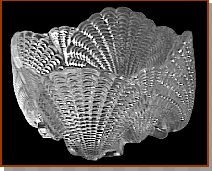 For some time, I've been trying to identify this 'pattern glass' bowl.
I looked for it in the pattern glass books with no luck. Well I should have
just looked at the shade on a 50's
Southern Belle
'boudoir' lamp. Evidently the manufacturer used the mold for the shade for a bowl also. Many thanks to the folks at the EAPG Society for suggesting that it looked similar to the shades on such lamps. If I had ever turned the bowl upside down, I might have recognized it.
For some time, I've been trying to identify this 'pattern glass' bowl.
I looked for it in the pattern glass books with no luck. Well I should have
just looked at the shade on a 50's
Southern Belle
'boudoir' lamp. Evidently the manufacturer used the mold for the shade for a bowl also. Many thanks to the folks at the EAPG Society for suggesting that it looked similar to the shades on such lamps. If I had ever turned the bowl upside down, I might have recognized it.
Can You Help Identify This Pattern??
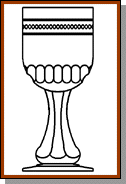 We would like identify the pattern, manufacturer, and period of manufacture of
this crystal stemmed cordial (2" D x 4" H ). My drawing shows the stem rather
thicker than it actually is. The glass and molding is not of high
quality. There are two mold marks descending from the rim and visible on the base.
We would like identify the pattern, manufacturer, and period of manufacture of
this crystal stemmed cordial (2" D x 4" H ). My drawing shows the stem rather
thicker than it actually is. The glass and molding is not of high
quality. There are two mold marks descending from the rim and visible on the base.
I have looked for this pattern in McCain, Revi, and Jenks and Luna but have
found nothing quite like it. It may well just be a 'depression glass' dime-store
piece, but perhaps I just missed it, let me know if you
are familiar with this pattern.
Al



| 
